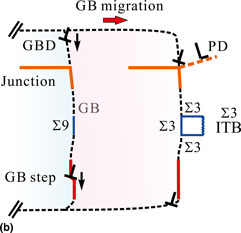Crossref Citations
This article has been cited by the following publications. This list is generated based on data provided by
Crossref.
Zhang, Liang
Lu, Cheng
Michal, Guillaume
Tieu, Kiet
Zhao, Xing
and
Deng, Guanyu
2017.
Influence of temperature and local structure on the shear-coupled grain boundary migration.
physica status solidi (b),
Vol. 254,
Issue. 4,
p.
1600477.
Luo, Xue-Mei
Li, Xi
and
Zhang, Guang-Ping
2017.
Forming incoherent twin boundaries: a new way for nanograin growth under cyclic loading.
Materials Research Letters,
Vol. 5,
Issue. 2,
p.
95.
Zhang, Liang
Lu, Cheng
and
Shibuta, Yasushi
2018.
Shear response of grain boundaries with metastable structures by molecular dynamics simulations.
Modelling and Simulation in Materials Science and Engineering,
Vol. 26,
Issue. 3,
p.
035008.
Luo, XueMei
Zhang, Bin
and
Zhang, GuangPing
2019.
Fatigue of metals at nanoscale: Metal thin films and conductive interconnects for flexible device application.
Nano Materials Science,
Vol. 1,
Issue. 3,
p.
198.
Tan, Fusheng
Fang, Qihong
Li, Jia
and
Feng, Hui
2020.
Enhanced nanotwinning by special grain growth in nanocrystalline materials.
Journal of Materials Science,
Vol. 55,
Issue. 8,
p.
3618.
Cavaliere, Pasquale
2021.
Fatigue and Fracture of Nanostructured Materials.
p.
105.
Zhou, Guofeng
Huang, Qishan
Chen, Yingbin
Yu, Xiongqing
and
Zhou, Haofei
2022.
Annihilation Mechanism of Low-Angle Grain Boundary in Nanocrystalline Metals.
Metals,
Vol. 12,
Issue. 3,
p.
451.
Zheng, Guikai
Wang, Qi
Chen, Jinfan
Qiu, Ruizhi
and
Zhu, Min
2023.
Quantifying Local Atomic Distortions in UO2 Grain Boundaries: Correlation with Energetic and Electronic Properties.
Inorganic Chemistry,
Vol. 62,
Issue. 39,
p.
16047.
